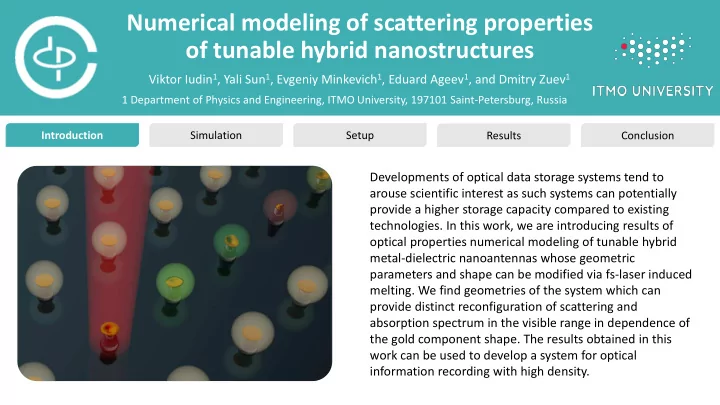

Numerical modeling of scattering properties of tunable hybrid nanostructures Viktor Iudin 1 , Yali Sun 1 , Evgeniy Minkevich 1 , Eduard Ageev 1 , and Dmitry Zuev 1 1 Department of Physics and Engineering, ITMO University, 197101 Saint-Petersburg, Russia Introduction Simulation Setup Results Conclusion Developments of optical data storage systems tend to arouse scientific interest as such systems can potentially provide a higher storage capacity compared to existing technologies. In this work, we are introducing results of optical properties numerical modeling of tunable hybrid metal-dielectric nanoantennas whose geometric parameters and shape can be modified via fs-laser induced melting. We find geometries of the system which can provide distinct reconfiguration of scattering and absorption spectrum in the visible range in dependence of the gold component shape. The results obtained in this work can be used to develop a system for optical information recording with high density.
Numerical modeling of scattering properties of tunable hybrid nanostructures Viktor Iudin, Yali Sun, Evgeniy Minkevich, Eduard Ageev, and Dmitry Zuev Introduction Simulation Setup Results Conclusion ACS for different diameter of nanoantenna ACS for different shape of nanoantenna Ti: Sapphire Ti: Sapphire d 250000 disk cup 200000 d=200 nm sphere ACS, nm 2 150000 d=220 nm d=240 nm 100000 d=300 nm 50000 ACS, a.u. 0 600 800 1000 1200 Wavelength, nm Au Si Wavelegth, nm
Numerical modeling of scattering properties of tunable hybrid nanostructures Viktor Iudin, Yali Sun, Evgeniy Minkevich, Eduard Ageev, and Dmitry Zuev Introduction Simulation Setup Results Conclusion Setup for laser modification Setup for DF spectroscopy D E E F D C B C G F A B A A – Ti: Sapphire fs-laser A – Halogen lamp E – Beam splitter B, C, D – Attenuator B – Polarizer F – Spectrometer E – Beam delivery system C – Objectives F, G – Beam positioning system D – CCD camera
Numerical modeling of scattering properties of tunable hybrid nanostructures Viktor Iudin, Yali Sun, Evgeniy Minkevich, Eduard Ageev, and Dmitry Zuev Introduction Simulation Setup Results Conclusion Measured DF spectra of nanoantennas DF images of modified structures in massive of particles S-pol P-pol SEM S-pol P-pol 78.1 J/cm 2 67.0 J/cm 2 Intensity, a.u. 49.1 J/cm 2 0 J/cm 2 1 um 1 um Wavelength, nm Wavelength, nm
Numerical modeling of scattering properties of tunable hybrid nanostructures Viktor Iudin 1 a) , Yali Sun 1 , Evgeniy Minkevich 1 , Eduard Ageev 1 , and Dmitry Zuev 1 1 Department of Physics and Engineering, ITMO University, 197101 Saint-Petersburg, Russia Introduction Simulation Setup Results Conclusion We investigate the influence of the gold component shape of hybrid nanoantenna on the scattering and absorption properties of the system. In these calculations, we take into account optimal parameters of initial gold disk geometry suitable for modification on the operation wavelength of solid state Ti: Sapphire laser. The results of the experiments demonstrate that the structures are potentially can be used as application for optical data storage system with high density. V International Conference on Metamaterials and Nanophotonics METANANO 2020 a) Corresponding author: viktor.iudin@metalab.ifmo.ru
Recommend
More recommend